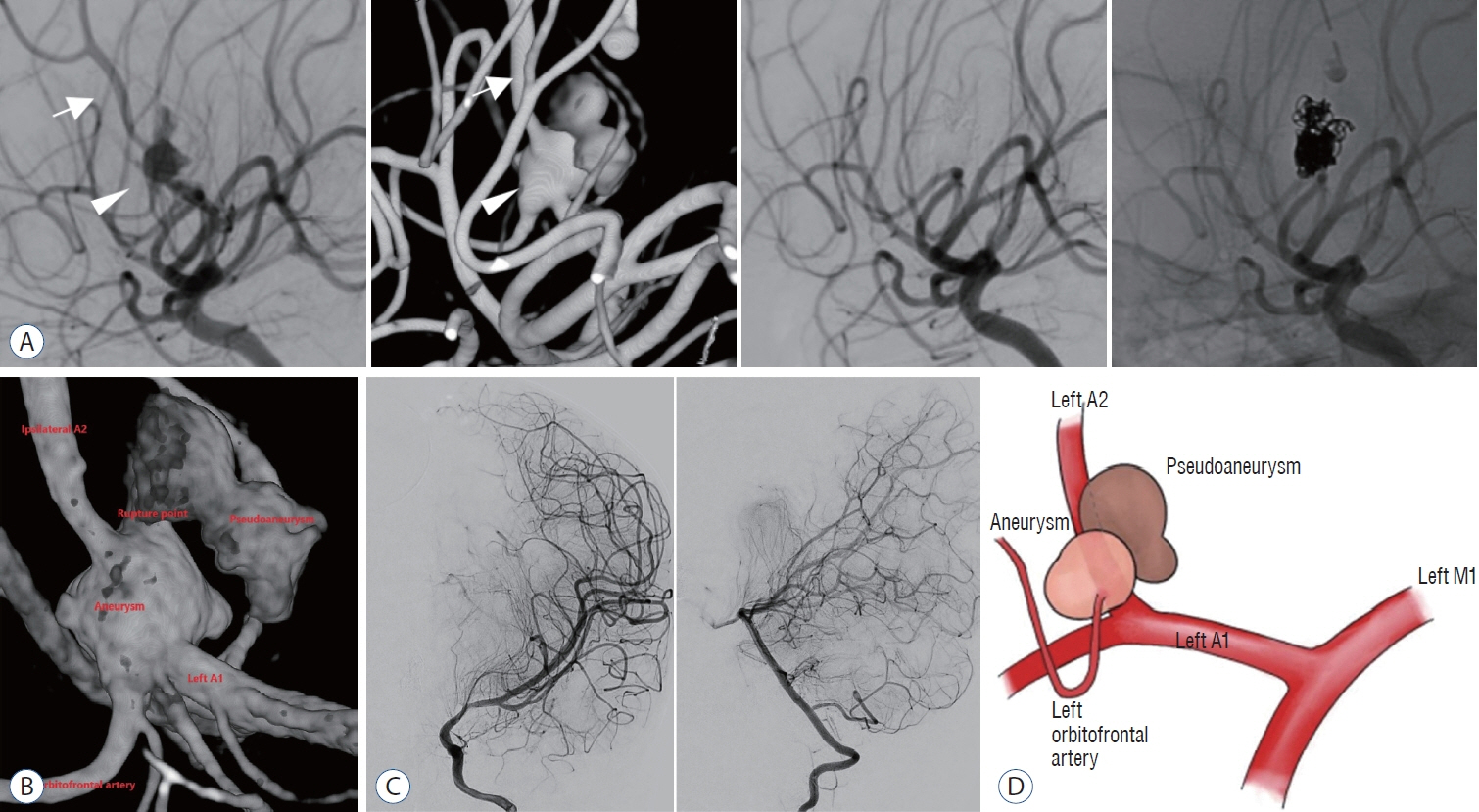J Korean Neurosurg Soc.
2023 Nov;66(6):743-747. 10.3340/jkns.2022.0201.
Ruptured Fusiform Anterior Cerebral Artery Aneurysm in an Infant : Case Report and a Literature Review
- Affiliations
-
- 1Department of Neurosurgery, Jeju National University Hospital, Jeju National University College of Medicine, Jeju, Korea
- 2Department of Neurosurgery, Seoul National University Hospital, Seoul National University College of Medicine, Seoul, Korea
- KMID: 2547468
- DOI: http://doi.org/10.3340/jkns.2022.0201
Abstract
- Ruptured intracranial aneurysms in infants are rare and infantile fusiform anterior cerebral artery (ACA) aneurysms are much rarer. In this report, we described the case of a 7-month-old infant with a ruptured fusiform ACA aneurysm who presented with seizure and underwent endovascular treatment. The patient was initially in a coma and the neurologic condition did not improve after treatment. The clinical characteristics of the case and literature review were discussed.
Figure
Reference
-
References
1. Beez T, Steiger HJ, Hänggi D. Evolution of management of intracranial aneurysms in children: a systematic review of the modern literature. J Child Neurol. 31:773–783. 2016.
Article2. Bonasia S, Smajda S, Ciccio G, Bojanowski MW, Robert T. Embryology of the anterior communicating artery complex: implications on possible adult variants. Surg Radiol Anat. 44:737–748. 2022.
Article3. Buis DR, van Ouwerkerk WJ, Takahata H, Vandertop WP. Intracranial aneurysms in children under 1 year of age: a systematic review of the literature. Childs Nerv Syst. 22:1395–1409. 2006.
Article4. Chiron C, Raynaud C, Mazière B, Zilbovicius M, Laflamme L, Masure MC, et al. Changes in regional cerebral blood flow during brain maturation in children and adolescents. J Nucl Med. 33:696–703. 1992.5. Garg K, Singh PK, Sharma BS, Chandra PS, Suri A, Singh M, et al. Pediatric intracranial aneurysms--our experience and review of literature. Childs Nerv Syst. 30:873–883. 2014.
Article6. Gemmete JJ, Toma AK, Davagnanam I, Robertson F, Brew S. Pediatric cerebral aneurysms. Neuroimaging Clin N Am. 23:771–779. 2013.
Article7. Ikeuchi Y, Koyama J, Azumi M, Akutsu N, Kawamura A, Kohmura E. Case report: anterior cerebral artery pediatric fusiform thrombosed giant aneurysm. Interdiscip Neurosurg. 19:100561. 2020.
Article8. Lasjaunias P, Wuppalapati S, Alvarez H, Rodesch G, Ozanne A. Intracranial aneurysms in children aged under 15 years: review of 59 consecutive children with 75 aneurysms. Childs Nerv Syst. 21:437–450. 2005.
Article9. Mohotti JE, Carter NS, Zhang VJW, Lai LT, Xenos C, Asadi H, et al. Neonatal intracranial aneurysms: case report and review of the literature. J Neurosurg Pediatr. 21:471–477. 2018.
Article10. Molyneux AJ, Kerr RS, Yu LM, Clarke M, Sneade M, Yarnold JA, et al. International subarachnoid aneurysm trial (ISAT) of neurosurgical clipping versus endovascular coiling in 2143 patients with ruptured intracranial aneurysms: a randomised comparison of effects on survival, dependency, seizures, rebleeding, subgroups, and aneurysm occlusion. Lancet. 366:809–817. 2005.
Article11. Padget DH. Development of cranial arteries in human embryo. Contrib Embryol. 32:205–262. 1948.12. Rao VY, Shah KB, Bollo RJ, Mawad ME, Whitehead WE, Curry DJ, et al. Management of ruptured dissecting intracranial aneurysms in infants: report of four cases and review of the literature. Childs Nerv Syst. 29:685–691. 2013.
Article13. Saraf R, Shrivastava M, Siddhartha W, Limaye U. Intracranial pediatric aneurysms: endovascular treatment and its outcome. J Neurosurg Pediatr. 10:230–240. 2012.
Article14. Tekkök IH, Ventureyra EC. Spontaneous intracranial hemorrhage of structural origin during the first year of life. Childs Nerv Syst. 13:154–165. 1997.
Article15. Xu R, Xie ME, Yang W, Gailloud P, Caplan JM, Jackson CM, et al. Epidemiology and outcomes of pediatric intracranial aneurysms: comparison with an adult population in a 30-year, prospective database. J Neurosurg Pediatr. 28:685–694. 2021.
Article16. Yatomi K, Oishi H, Yamamoto M, Suga Y, Nonaka S, Yoshida K, et al. Radiological changes in infantile dissecting anterior communicating artery aneurysm treated endovascularly. A case report and five-year follow-up. Interv Neuroradiol. 20:796–803. 2014.
Article
- Full Text Links
- Actions
-
Cited
- CITED
-
- Close
- Share
- Similar articles
-
- Fusiform Aneurysm of Proximal Anterior Cerebral Artery: Case Report
- Ruptured Aneurysm Arising from a Fenestrated A1 Segment of the Anterior Cerebral Artery
- A Ruptured Aneurysm in a Patient with Systemic Lupus Erythematosus: Case Report
- Ruptured proximal anterior cerebral artery (A1) aneurysm located at an anomalous branching of the fronto-orbital artery--a case report
- Aneurysms of the Proximal Anterior Cerebral Artery



